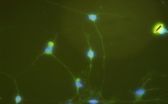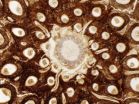(Press-News.org) To date, it remains poorly understood whether astrocytes can be easily reprogrammed into neurons. Mash1 and Brn2 have been previously shown to cooperate to reprogram fibroblasts into neurons. Dr. Yongjun Wang and team from Shanghai University of Traditional Chinese Medicine in China found that and found that Brn2 was expressed in astrocytes from 2-month-old Sprague-Dawley rats, but Mash1 was not detectable. Thus, the researchers hypothesized that Mash1 alone could be used to reprogram astrocytes into neurons. Murine stem cell virus (MSCV)-Mash1 recombinant plasmid was constructed and transfected into GP2-293t cells to produce retrovirus. One week later, the changes in morphology of astrocytes were detectable, which showed typical neuronal characteristics. Moreover, β-tubulin expression levels were significantly higher in astrocytes expressing Mash1 than in control cells. These results, published in the Neural Regeneration Research (Vol. 9, No. 1, 2014), indicate that Mash1 alone can reprogram astrocytes into neurons. This method determined an easier process of reprogramming through the endogenous expression of important transcription factors, which avoids malignant transformation due to the spontaneous reactivation of viral transgenes.
INFORMATION:
Article: " Mash1 efficiently reprograms rat astrocytes into neurons" by Daofang Ding1, 2, Leqin Xu1, 2, Hao Xu1, 2, Xiaofeng Li1, 2, Qianqian Liang1, 2, Yongjian Zhao1, 2, Yongjun Wang1, 2 (1 Institute of Spine, Shanghai University of Traditional Chinese Medicine, Shanghai, China; 2 Longhua Hospital, Shanghai University of Traditional Chinese Medicine, Shanghai, China)
Ding DF, Xu LQ, Xu H, Li XF, Liang QQ, Zhao YJ, Wang YJ. Mash1 efficiently reprograms rat astrocytes into neurons . Neural Regen Res. 2014;9(1):25-32.
Contact: Meng Zhao
eic@nrren.org
86-138-049-98773
Neural Regeneration Research
http://www.nrronline.org/
Who reprograms rat astrocytes into neurons?
2014-03-21
ELSE PRESS RELEASES FROM THIS DATE:
Unique chromosomes preserved in Swedish fossil
2014-03-21
Researchers from Lund University and the Swedish Museum of Natural History have made a unique discovery in a well-preserved fern that lived 180 million years ago. Both undestroyed cell nuclei and individual chromosomes have been found in the plant fossil, thanks to its sudden burial in a volcanic eruption.
The well-preserved fossil of a fern from the southern Swedish county of Skåne is now attracting attention in the research community. The plant lived around 180 million years ago, during the Jurassic period, when Skåne was a tropical region where the fauna was dominated ...
A study using Drosophila flies reveals new regulatory mechanisms of cell migration
2014-03-21
Cell migration is highly coordinated and occurs in processes such as embryonic development, wound healing, the formation of new blood vessels, and tumour cell invasion. For the successful control of cell movement, this process has to be determined and maintained with great precision. In this study, the scientists used tracheal cells of the fruit fly Drosophila melanogaster to unravel the signalling mechanism involved in the regulation of cell movements.
The research describes a new molecular component that controls the expression of a molecule named Fibroblast Growth ...
Switching an antibiotic on and off with light
2014-03-21
This news release is available in German. Scientists of the KIT and the University of Kiev have produced an antibiotic, whose biological activity can be controlled with light. Thanks to the robust diarylethene photoswitch, the antimicrobial effect of the peptide mimetic can be applied in a spatially and temporally specific manner. This might open up new options for the treatment of local infections, as side effects are reduced. The researchers present their photoactivable antibiotic with the new photomodule in a "Very Important Paper" of the journal "Angewandte Chemie". ...
cfaed presents the new microchip 'Tomahawk 2' at the DATE'14 in Dresden
2014-03-21
The Center for Advancing Electronics Dresden (cfaed) presents its new microchip 'Tomahawk 2' at the DATE'14 Conference in the International Congress Center Dresden from March 24 to 28, 2014. The new Tomahawk is extremely fast, energy-efficient and resilient. It is a heterogeneous multi-processor which can easily integrate very different kinds of devices. The researchers of the Cluster of Excellence for microelectronics of Technische Universität Dresden use the new prototype to prepare the so-called 'tactile internet'. With this, very big data volumes shall be transmitted ...
New study shows we work harder when we are happy
2014-03-21
Happiness makes people more productive at work, according to the latest research from the University of Warwick.
Economists carried out a number of experiments to test the idea that happy employees work harder. In the laboratory, they found happiness made people around 12% more productive.
Professor Andrew Oswald, Dr Eugenio Proto and Dr Daniel Sgroi from the Department of Economics at the University of Warwick led the research.
This is the first causal evidence using randomized trials and piece-rate working. The study, to be published in the Journal of Labor Economics, ...
Surprising new way to kill cancer cells
2014-03-21
Northwestern Medicine scientists have demonstrated that cancer cells – and not normal cells – can be killed by eliminating either the FAS receptor, also known as CD95, or its binding component, CD95 ligand.
"The discovery seems counterintuitive because CD95 has previously been defined as a tumor suppressor," said lead investigator Marcus Peter, professor in medicine-hematology/Oncology at Northwestern University Feinberg School of Medicine. "But when we removed it from cancer cells, rather than proliferate, they died."
The findings were published March 20 in Cell Reports. ...
Stem cell study finds source of earliest blood cells during development
2014-03-21
Irvine, Calif., March 20, 2014 — Hematopoietic stem cells are now routinely used to treat patients with cancers and other disorders of the blood and immune systems, but researchers knew little about the progenitor cells that give rise to them during embryonic development.
In a study published April 8 in Stem Cell Reports, Matthew Inlay of the Sue & Bill Gross Stem Cell Research Center and Stanford University colleagues created novel cell assays that identified the earliest arising HSC precursors based on their ability to generate all major blood cell types (red blood ...
New infrared technique aims to remotely detect dangerous materials
2014-03-21
For most people, infrared technology calls to mind soldiers with night-vision goggles or energy audits that identify where heat escapes from homes during the winter season.
But for two Brigham Young University professors, infrared holds the potential to spot from afar whether a site is being used to make nuclear weapons.
Statistics professor Candace Berrett developed a model that precisely characterizes the material in each pixel of an image taken from a long-wave infrared camera. The U.S. National Nuclear Security Administration funded the project through a grant ...
The gene family linked to brain evolution is implicated in severity of autism symptoms
2014-03-21
The same gene family that may have helped the human brain become larger and more complex than in any other animal also is linked to the severity of autism, according to new research from the University of Colorado Anschutz Medical Campus.
The gene family is made up of over 270 copies of a segment of DNA called DUF1220. DUF1220 codes for a protein domain – a specific functionally important segment within a protein. The more copies of a specific DUF1220 subtype a person with autism has, the more severe the symptoms, according to a paper published in the PLoS Genetics. ...
Stanford professor maps by-catch as unintended consequence of global fisheries
2014-03-21
Seabirds, sea turtles and marine mammals such as dolphins may not appear to have much in common, other than an affinity for open water. The sad truth is that they are all unintended victims – by-catch – of intensive global fishing. In fact, accidental entanglement in fishing gear is the single biggest threat to some species in these groups.
A new analysis co-authored by Stanford biology Professor Larry Crowder provides an unprecedented global map of this by-catch, starkly illustrating the scope of the problem and the need to expand existing conservation efforts in certain ...




